Why Virtual Learning Has Become Foundational
If you’re a nurse educator, you might agree that virtual learning technologies are here to stay. We’ve undergone an incredible evolution since 2019 and pre-pandemic. That’s when we first wrote about the topic of why nursing students seek learning in a virtual environment. Virtual learning has since transformed from being a welcome addition to teaching in 2019 to what is now a necessity in 2022 and beyond.
Virtual simulation has proven to be more valuable than we ever imagined. This is not only in terms of teaching sound clinical reasoning and decision-making skills, but also in its ease of access and ability to supplement other forms of simulation.
Pre-pandemic, you may have seen headlines that state “millennials are technology-dependent” or “millennial attention spans are decreasing.” The science behind these claims is lacking and often disputed. The impact of technology on the learning environment, however, is unquestionable. And it’s not just millennial learners that are affected. What 2020 and 2021 have shown us is that we’re all technology-dependent.
The number of adults in the U.S. who own a smartphone has risen to 85%1, an increase from 77% in 20192. And 90% of adults in the U.S. say that the internet has been essential or important for them personally during the pandemic.3 The search for information is no longer a time consuming one, with Google at our fingertips and in our very back pockets. And even those who were most resistant to using the net as a regular part of their life have had to change.
What all of this means is that learners today are constantly seeking new information, are exposed to more information in a day than previous generations, and are more prone to multitasking.4 Adult learning theory dating back to the work of John Dewey, the father of progressive schooling, points to the need for experiential, experimental, and hands-on learning experiences. Because digital media has become all-consuming, emerging learning styles include a balance of experiential learning, guided mentoring, and collective reflection.
What this all means is that in order to meet the needs of modern-day learners, you need to deliver on their terms.
Today’s students need more than didactic learning. They seek to interact with the material in a way they are comfortable with – and that’s online.
In this article, we revisit why virtual simulation is an important element in producing practice-ready nurses in 2022.
The Delivery Model Has Changed
Nurse educators’ adoption of digital technologies in nursing education grew exponentially as programs pivoted to distance learning. Unsurprisingly, 91% of nursing programs are now using virtual simulation6 - an increase from 65% in 20167. Other quickly-growing technologies include learning management systems, video for skills, adaptive quizzing, and EHR applications.8
Virtual simulation and other technologies have taken permanent root in nursing education. The future of virtual simulation will be less about the learning curve of adopting it and more about how educators can apply lessons already learned.

of nursing programs plan to invest even further in virtual simulation.9
By 2025, nursing programs are predicted to begin embracing more advanced technologies – including virtual reality, mobile apps, video capture software, wearables, and makerspaces.10
Some of the drivers behind these adoptions include: 11
- Pandemic changing education models
- Reduction in number of available clinical sites
- To increase clinical judgment skills
Nursing programs that have larger numbers of enrolled students tend to adopt new technologies more readily, compared to nursing programs that accept fewer students.12 It’s all about economy of scale.
If you’re a small organization, virtual simulation allows you to leapfrog into new technology and leverage it where human teaching resources are not available. Online training methods can reduce the overall time and cost of a lesson, while maintaining learner satisfaction, confidence, and learning outcomes.13
Virtual Simulation Helps Students Walk Before They Run
David Kolb first published his experiential learning theory in 1984, based on the earlier works of John Dewey.14 His four-stage cycle of learning, and four learning styles that he defined, still heavily influence educational courses today. We, at Laerdal, were so inspired by his model that we used it as the basis to create our model, the Circle of Learning.
Kolb’s experiential learning cycle defines four stages that a learner should progress through:
- Concrete Experience - A new experience or a reinterpretation of an experience.
- Reflective Observation - Interpreting the inconsistencies between experience and understanding.
- Abstract Conceptualization - The formation of a new idea or changes to an existing idea.
- Active Experimentation - The learner applies knowledge in future situations, resulting in new experiences.
Essential to this theory is the idea that a student must progress through all four stages in order to effectively learn. This implies that no teaching strategy on its own should be the be-all and end-all to effective teaching. For nursing curricula, it is the combination of didactic, hands-on training, simulation, and clinical experience that prove most effective.
Virtual simulation allows learners to treat a virtual patient, gathering their medical history and practicing patient-centered care, without the threat of patient harm. Learners are immersed in an online experience that accomplishes the Reflective Observation stage of Kolb’s cycle. Drawing from textbook and lecture content, learners are engaged in the scenario and make critical decisions about the patient’s care.
Experts have recommended virtual patients as a learning activity that can support nursing students in their scientific knowledge, while helping them to integrate theory into practice.15 The repeatability of the scenarios, in conjunction with the debriefing, allows learners to back-track each decision and compare it to evidence-based practices and protocols.
Virtual simulation affords learners a chance to test their knowledge before participating in a full-fledged simulation and, more importantly, before they step foot into a hospital.
E-Learning Can Tell a Story – and Stories Stick
As the internet has grown into the mammoth source that it is today, the applications and effectiveness of eLearning have continued to improve. Research has shown that up to 60% better consistency of learning can be achieved through technology-based training.16
E-Learning can increase retention rates by17

Virtual simulation requires learners to draw on what they’ve been taught and begin testing the application of their skills. Each scenario follows a storyline, integrating video, patient interactions, and pre- and post-simulation quizzes. While achieving the benefits of eLearning, virtual simulations that include the element of story provide additional advantages to the learning experience.
"Simulation and [stories] can move faculty from simply depositing content to using content in different creative ways as part of their teaching agenda and, ultimately, to match curriculum to course learning outcomes."
Elaine Tagliareni, EdD, RN, CNE, FAAN, and Susan Forneris, PhD, RN, CNE, CHSE-A, from the National League for Nursing (NLN)18
Learners that can follow a story, from start to finish, and see the results of their decisions and actions will be better able to conceptualize safe practices. Virtual simulation provides a safe, effective, and simple online environment to practice critical-thinking and decision-making skills that every nurse needs.
Interested in a vSim consultation and free trial?

Our surveys have shown that faculty who used vSim for Nursing as prep work in advance of human patient simulation reported that students were more comfortable meeting the same patient in the simulation lab, and that students performed better on human patient simulations that included more complexity and integrated psychomotor skills.
Let us guide you through the different vSim for Nursing courses, instructor tools, and usage models.
Related Products

References
- Pew Research Center. (2021). Mobile Fact Sheet. Retrieved from https://www.pewresearch.org/internet/fact-sheet/mobile/
- Rainie, L. & Perrin, A. (2017). 10 facts about smartphones as the iphone turns 10. Pew Research Center. Retrieved from http://www.pewresearch.org/fact-tank/2017/06/28/10-facts-about-smartphones/
- McClain, C., Vogels, E., Perrin, A., Sechopoulos, S. & Rainie, L. (2021). The Internet and the Pandemic. Pew Research Center. Retrieved from https://www.pewresearch.org/internet/2021/09/01/the-internet-and-the-pandemic/
- American Press Institute. (2015). How millennials get news: Inside the habit of America’s first digital generation. Retrieved from https://www.americanpressinstitute.org/publications/reports/survey-research/millennials-news/
- Dede, C. (2005). Planning for neomillennial learning styles. Educause Quarterly, 1. Retrieved from http://www.wou.edu/~girodm/670/Dede_on_neo-millenials.pdf
- Wolters Kluwer and the National League for Nursing. (2021). Forecast for the Future: Technology Trends in Nursing Education. Retrieved from https://www.wolterskluwer.com/en/solutions/lippincott-nursing-faculty/dean-survey
- Wolters Kluwers. (n.d.). How nursing education programs are currently using educational technology. Retrieved from http://nursingeducation.lww.com/content/dam/wk-nes/images/Nursing-Education-Technology.gif
- Wolters Kluwer and the National League for Nursing. See Reference #6.
- Ibid
- Ibid
- Ibid
- Wolters Kluwers. (n.d.). How nursing education programs are currently using educational technology. See Reference #7.
- Serwetnyk, T.M., Filmore, K., VonBacho, S., Cole, R., Miterko, C., Smith, C., et al. (2015). Comparison of online and traditional basic life support renewal training methods for registered professional nurses. Journal for Nurses in Professional Development, 31(6), E1-10. DOI: 10.1097/NND.0000000000000201
- McLeod, S. (2017). Kolb – learning styles. Retrieved from https://www.simplypsychology.org/learning-kolb.html
- Georg, C. & Zary, N. (2014). Web-based virtual patients in nursing education: Development and validation of theory-anchored design and activity models. Journal of Medical Internet Research, 16(4). DOI: 10.2196/jmir.2556
- Urdan, T.A. & Weggen, C.C. (2000). Corporate elearning: Exploring a new frontier. Berwyn, PA: WR Hambrecht & Co.
- Ibid
- Tagliareni, E. & Forneris, S. (n.d.) Sim beyond the sim lab. Retrieved from http://www.nln.org/docs/default-source/professional-development-programs/sim-beyond-the-sim-lab-(pdf).pdf?sfvrsn=0
